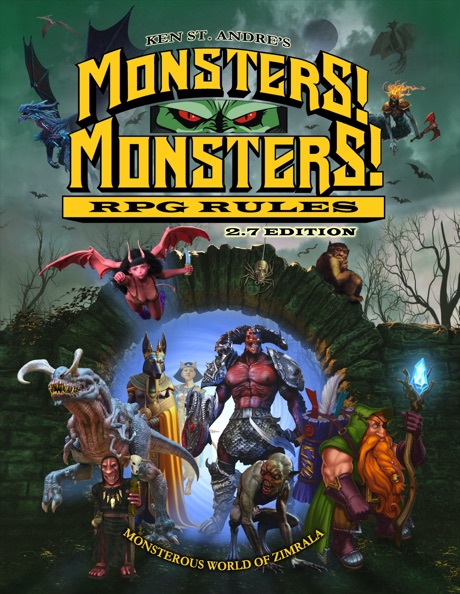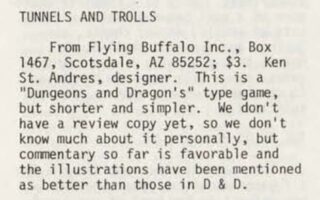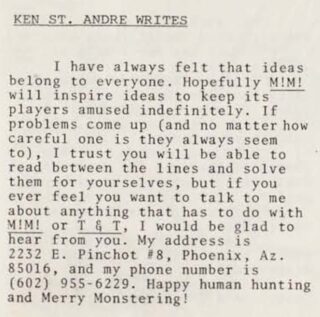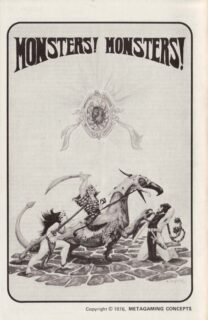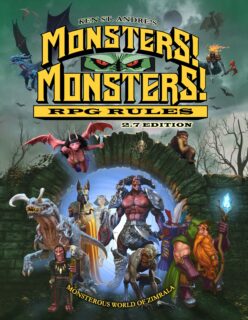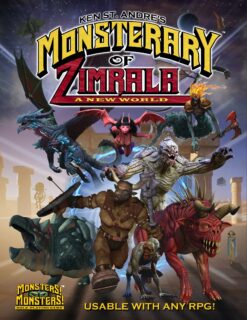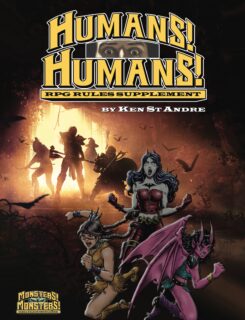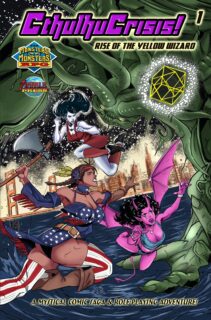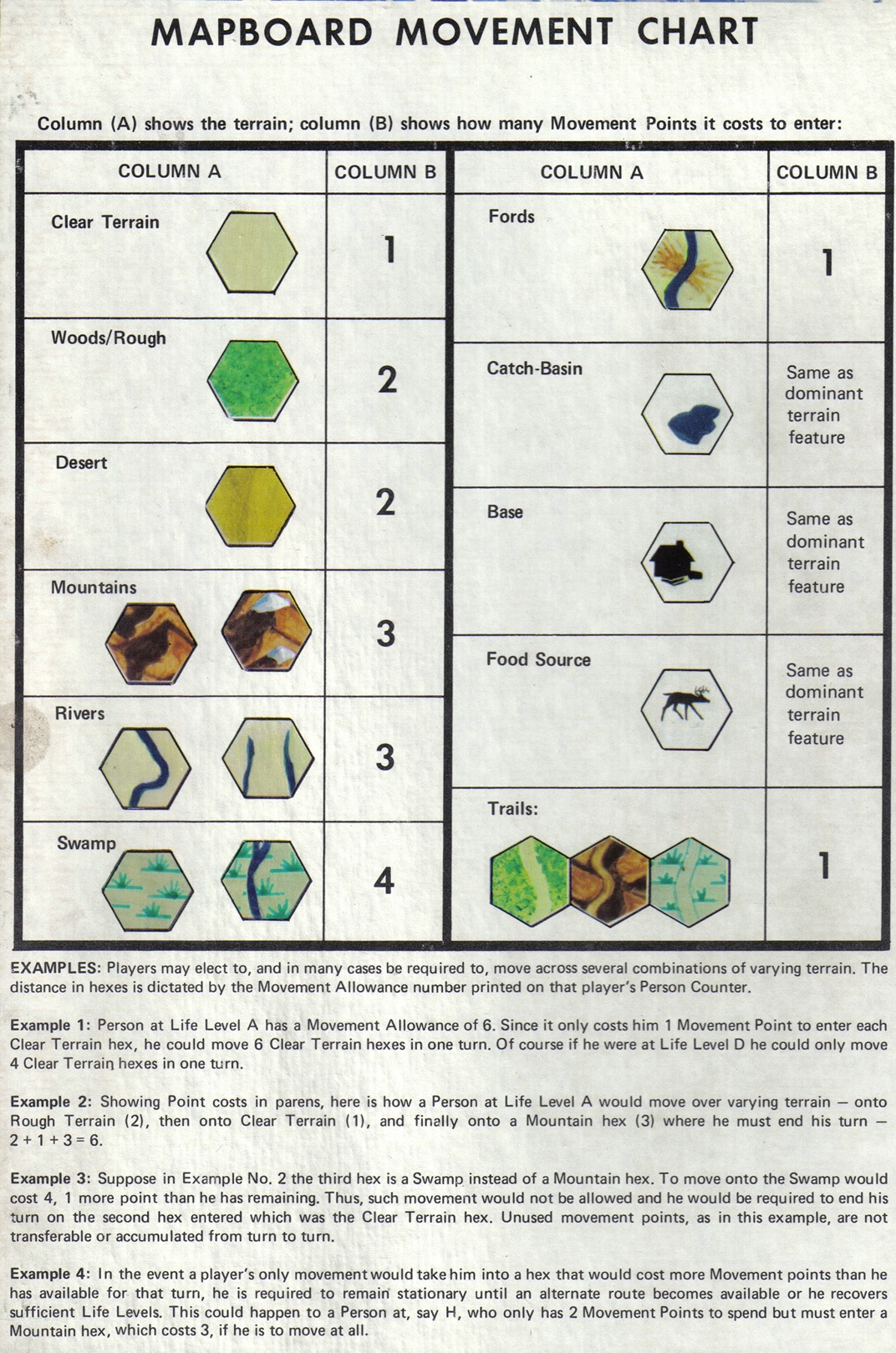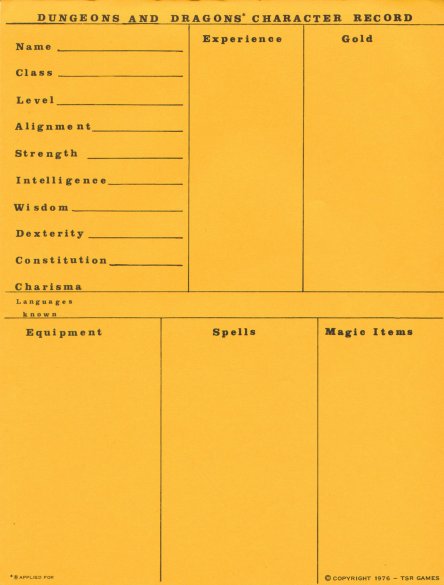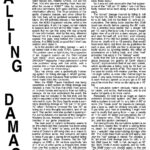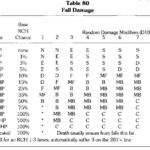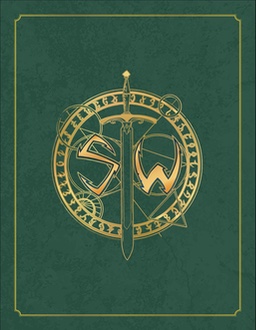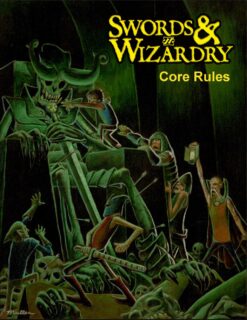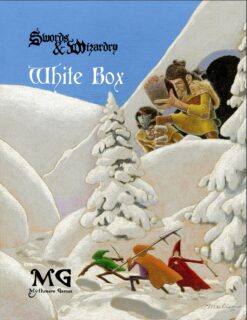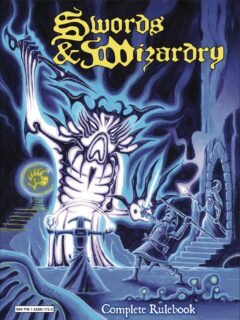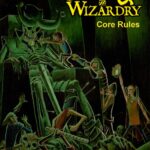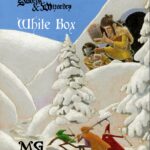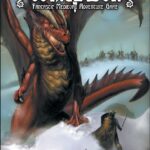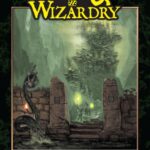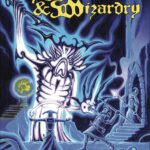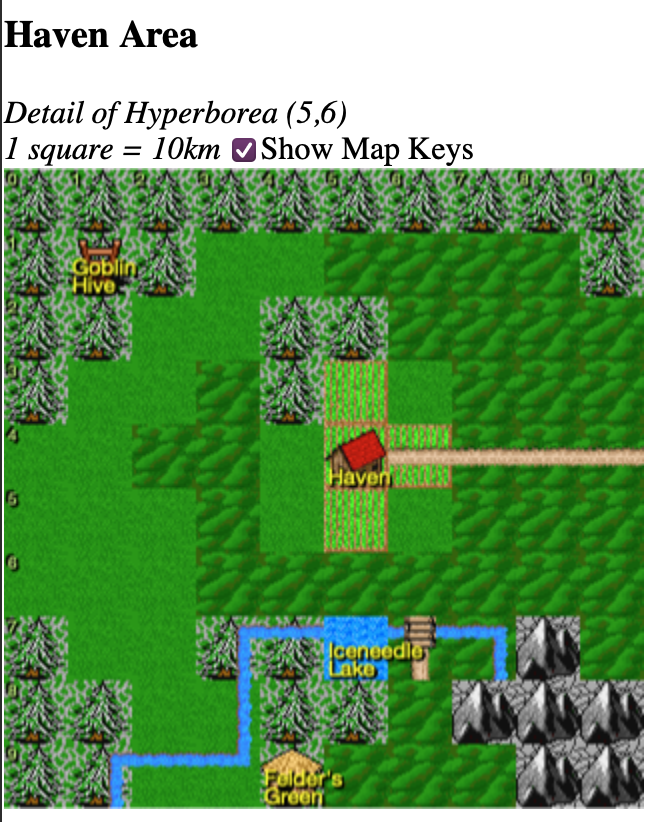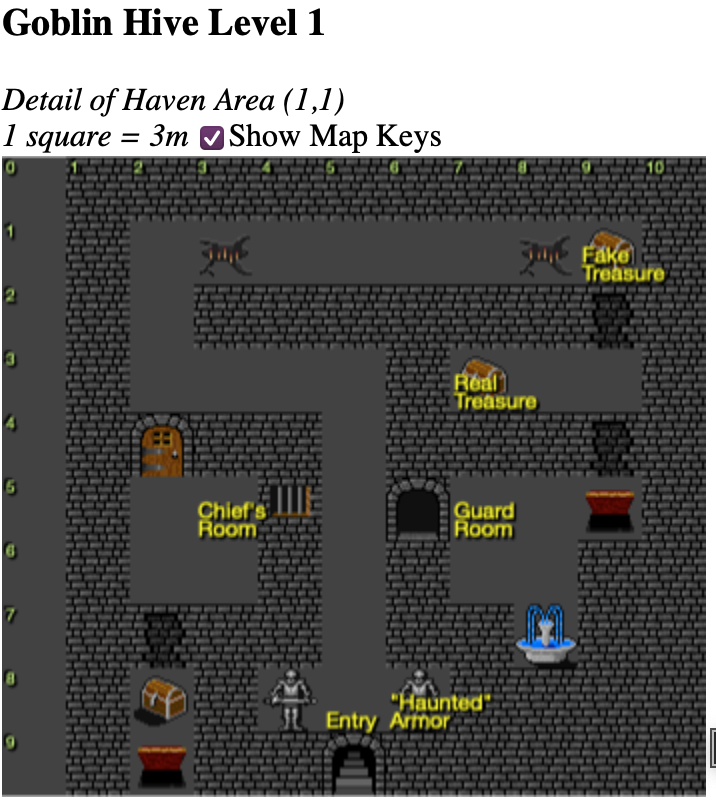Let me explain. No, there is too much, let me sum up.
Back in 1975, Tunnels & Trolls was the second RPG ever written. Space Gamer #2 has this:
T&T has a bunch of virtues, it's VERY simple, only uses 6-sided craps dice, it's very cheap, and it's less contradictory than D&D. By not trying to do everything, it succeeds at more.
In 1976, Rick Loomis' Buffalo Castle came out, introducing the world to solo adventure gamebooks! Years before "Pick Some Kinda Road" (lawsuit-happy owner) books.
Also in 1976, Monsters! Monsters! was unleashed on the world, turning the tables on those horrible adventurers and townsfolk, with playable monsters.
Many eons passed. T&T became the most popular soloing RPG, and a cult favorite for group play as well. It's always been my pick-up or teaching game, I can just bring out the City of Terrors pocket book, and have a full game and setting.
Often there were good mini-rules and adventures, in particular T&T Adventures Japan and the Beginner's Bundle, and the last edition, Deluxe Tunnels & Trolls and adventures updated for it.
More recently, Ken sold Tunnels & Trolls to a company which has done nothing much with what's left of Flying Buffalo. So he started focusing on the game he didn't sell: Monsters! Monsters!
In 2020, a new edition of Monsters! Monsters! came out, to go along with a new version of The Toughest Dungeon in the World (which assumes a Troll PC).
In 2022, Monsterary of Zimrala introduced a new setting, full of weirdo monsters.
And then in 2024, we got updated version of M!M! 2.7, and Steve Crompton's fantasy superhero/sexy times comics got a comic/sourcebook treatment, Cthulhu Crisis.
SO, that's what I'm gonna talk about here, the state of Tunneling & Trolling/Monstering Monstering these days.
Monsters! Monsters! 2.7
Cover is an arched portal, with monsters of all sorts coming thru. This works fine. The book is spiral-bound, on very heavy paper, which can be a little hard to flip thru but it's convenient at the table.
Ken promises a 3rd ed of M!M! will be more complete, but 2.7 is what we have now. It's fairly short, leads right into character creation by rolling stats (3d6 eight times as usual), picking species (no longer called Kindred) from Trolls (Forest or Jungle), Serpentmen, Uruks, Gremlins, or Zim (Zimralan Ogres). These have very simple stat modifications, not too far above Human.
Later in the book there's 28 Humanoids (Balrukh to Zombie), 22 Non-Humanoids (Basilisk to Unicorn), 26 Zimralan Humanoids (Bat Trolls to Zim), 7 Intelligent Demons (Anticorn to Xipe), all with typical T&T/M!M! stat multipliers and a special power! You can quickly get very powerful characters. Then another 78 non-statted monsters (they get one "Monster Rating" (MR) which serves as attack & defense!) for use as enemies. No playable Humans, Dwarfs, or Elfs!
Immediately drops into How To Do Combat, just 3 pages. It's a QUICK and EASY game. Every combatant rolls their weapon or monster dice, plus "combat adds" depending on stats, side with highest total inflicts the difference on the losers. There's a few specific rules for missiles, spells, armor, etc., but it's not meant to be hard or detailed, YOU invent the descriptions.
Saving Rolls (SR) are the main clever feature of all T&T/M!M! games, a roll directly against a stat, 2 dice, doubles add & roll over (DARO), plus stat score, target number is 20 at Level 1, +5 per Level. M!M! improves on previous editions by having a page explaining how to use Stunts, SRs in combat.
Chaos Factor is new, giving non-magic monsters a chance to adjust the dice. In my house rules, I require you to recharge your Chaos Factor with magic energy, Moon Crystals in Zimrala, but as written you can use it over and over, but only one monster per turn.
Adventure Points are experience. They're not well explained in 2.7, you SHOULD get them based on the MR/Level of defeated monsters, and a bunch of other things, but all that's listed is your SR rolls. More house rules time, which is fine, "make the game your own".
You directly spend AP to increase your stats, and your highest stat determines your Level, rather than saving AP up to Level, and maybe getting a +1 to something. Advancing your character is far more interesting in M!M! than that other game.
In even the first edition of T&T, there was a simple equipment list, then a VERY long detailed one with every historical & fantasy weapon & armor you'd want, with STR & DEX requirements, speical abilties, precise ranges… M!M! does not have this. It has a mini-rules level of items. Sure, many monsters don't use equipment, but it's still bad.
There's a very small list of 9 weapons for Egyptos (Humans brought from Earth). 11 weapons for the Zim, but they're massively overpowered (75d6 magic flint spear!). 20 Demon magic effects for weapons, which is helpful since T&T has never had a real magic weapon list. 3 special items for Dwarfs, a big table of generic guns, a few ray-guns for Curators and Advanced Humans.
Magic is next, with a reasonably good but low-Level spell list, 20 Level 1, 22 Level 2, 29 Level 3, 10 Level 4, 5 Level 5, 5 Level 6, 3 Level 7. As opposed to T&T, which had fewer spells, but went up to Level 17. I'm not thrilled that many of the spells got new names, or were pulled from Kindred-specific spellbooks, but that's more a matter of me relearning what's in there.
Monsters in Detail gives paragraph to quarter-page descriptions for dozens of monsters.
Ken St Andre has his own M!M! House Rules, because nobody plays any game the same way, including the authors. The really important one here is Spite Damage, which keeps combat from being a one-way death spiral.
There's a brief setting overview of Zimrala, two GM adventures of looting haunted, ruined towns. I must note a little indignantly that there's no scenario set up for invading a populated Human town and making off with their loot and pretty mates, or devouring people! That was the key attraction of M!M! 1st Ed, and it's still the most fun. Pretty obvious how to write it up, but the M!M! 1st Ed townsfolk table was more useful.
There's a Treasure Generator for coins & gems which has been in various T&T products for 40+ years.
An invitation to make new products for the M!M! system, a few of those have already come out.
★★★★½ - still needs a lot more equipment and more high-Level spells, but otherwise a kick-ass game. Usable as both a "normal" RPG or as a crazy monsters game.
Monsterary of Zimrala
Nearly the same cover as M!M!, but in a ruined temple and fewer monsters. As a bestiary, this is more fitting.
This world is connected to but not the same as the City of the Gods setting, where all the old pantheon gods ended up. There's a solo adventure, Mission for a Cat Goddess, where the goddess Sekhmet and Demi the Demoness ("Tenh-Mer") pull your character from wherever (Trollworld probably) to Zimrala.
The Zimrala setting is a typical giant continent with every terrain and culture mashed up. Perfectly serviceable as a gaming setting. The desert has been "invaded" by ancient Egyptians, in a colony of Sekh-Atem; there's a promise of a sourcebook but this hasn't come out yet. A long timeline for 28,000 years of prehistory. An excuse for Gristlegrim's Dwarfs to come to Zimrala. I really want a lot more setting, I'm spoiled maybe by DT&T's Trollworld chapter with multiple cities and a gazetteer in a bit more detail.
Magic on Zimrala is more interesting, adding Chaos Factor with a little better explanation. God Magic is divine intervention with no limits except GM caution. Demon Magic is always-on but a little more focused, 9 "Auras" of types of demons. Dwon (Demon Dwarfs) Magic is delusional religion, roll and see if your wish works. Moon Crystals can contain Wizardry power or specific spells or super-powerful effects, but also attract monsters called Etherdragons. Portals are all over Zimrala, leading to dimensions or into space!
Zimrala has 7 (or 8) moons, and most of these are habitable/explorable. There's not a lot of explanation in detail, but there is in Cthulhu Crisis.
Zimrala doesn't use coins, but gems, Amethysts are equivalent to GP or $, up to Moon Crystals worth $20,000.
So that's quite a lot, and only up to page 34! The majority of the book is bestiary, a page on Humans and near-Humans, animals, 68 monsters, 27 playable monsters, 6 demons, 12 demon monsters. These are often really weird and non-standard.
A short GM adventure/useful information site for monsters to explore.
And finally the Mini-Rules, just enough M!M! to be playable with this book alone.
★★★★☆ - great bestiary, very minimal as a setting book.
Humans! Humans!
Cover has scary humanoids, maybe Humans, Elfs, Dwarfs, and a Wizzard, busting into a nice safe dungeon, with the comic book characters pasted in front. Unimpressed.
One would hope this is the things monsters are scared of. It is instead more of a book for running Human & friendly PCs.
The book's pretty thin. Starting player & GM advice for surviving and not TPKing when facing the giant monsters of Zimrala as a squishy little Human. I'd just suggest not being one!
Humans, Dwarfs/Dwon (Demon Dwarfs), and Moon Elfs (ugh Warcraft) get stat multipliers, Professions, Skills, and 1 in 6 get Special Abilities. That's OK, mostly brings them up to monster power level. There's no stats for Fairies, Leprechauns, and "Hobbs", classic T&T kindred, and I kinda miss the first two.
Professions and Skills overlap a lot, but the Profession doesn't provide any fixed game benefit. Skills replace Talents, and have a Level, adding to Saving Rolls. Special abilities are somewhat rare, and range from Eagle Eyes to Divine Intervention, specific mechanics aren't given for everything but you can add to SRs also.
The Elven & Dwarfen Professions, Skills, & Abilities are each different.
Human Vampire & Avatar rules are also printed in the comics which they're based on. Vampires are fairly weak but are nearly impossible to kill permanently. Ken gives them 1 stat point per 100 years, to make 3000-year-old Vampirooni from the comics not be super-powerful. I'd do d6 x 100 years, and 5 stat points per century.
Avatars may be divinely-blessed like Erika Amerika or magic artifacts like Tessa Ract. It's purely up to the G.M. to decide what abilities these get.
But then there's 5 pages of equipment reprinted from M!M!, NOT new weapon charts, which would actually be useful.
★★★½☆ - does what you need for filling out Humans in M!M!, but I'm unimpressed by the Avatars, and the equipment repeat made me 🙁
Cthulhu Crisis, Vampirooni's Crisis
So, Steve Crompton and the late Randy Vogel had been writing these Vampirooni (Vampirella knockoff), Demi the Demoness (succubus), Erika Amerika (super-powered reincarnating Native American girl), and Kitt-Ra (Sekhmet's four-tittied cat goddess avatar) softcore porn comics for a long time. Which I often find this kind of thing entertaining, I'm a Richard Corben, Vaughn Bode, Robert Crumb, etc. kind of sleazy Zap Comix kinda guy.
The Crisis comics start on Earth present & near future, Tessa Ract (get it tesseract), and an evil vampire from ancient Egypt, a Moth Girl and Squid Schoolgirl working for the Yellow Wizard Hastur, who colludes with Cthulhu, wreck their days. There's a dumpster full of dead ninjas, the god Set, spaceships, and a skull asteroid base.
On the one hand again this is generally my jam in comics, but as M!M! sourcebook it's really not at all what I do. Some parts are useful, each issue has a mini-GM adventure/location. None are related to Zimrala, and only a bit to City of the Gods. But I'm sure not putting Vampi in my games.
★★★★☆ style but ★★☆☆☆ utility.
